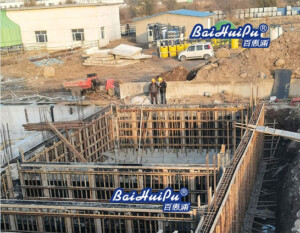There are many treatment methods for the problem of excessive ammonia nitrogen in medical wastewater. The following are some effective strategies:
1. Biological method
Biological method is a treatment method based on biological principles. It uses certain microorganisms to degrade ammonia nitrogen, thereby reducing the concentration of ammonia nitrogen. This method has the advantages of environmental protection, economy and sustainability.
1. Activated sludge method: Use microorganisms in activated sludge to nitrify ammonia nitrogen and convert it into nitrate. This method is suitable for treating medium and low concentrations of ammonia nitrogen wastewater.
2. Biofilm method: Degrade ammonia nitrogen through microorganisms on biofilm. The biofilm method has the advantages of high treatment efficiency and small footprint, and is suitable for treating high-concentration ammonia nitrogen wastewater.

2. Physical method
Physical method refers to the method of treating excessive ammonia nitrogen by physical principles to achieve the purpose of reducing the concentration of ammonia nitrogen.
1. Adsorption method: Use adsorbents (such as activated carbon, zeolite, etc.) to adsorb ammonia nitrogen, so as to achieve the purpose of purifying water quality. This method is suitable for treating low-concentration ammonia nitrogen wastewater.
2. Membrane separation technology: The wastewater is separated and concentrated by the selective permeability of the membrane, which can effectively remove ammonia nitrogen from the wastewater. Common membrane separation technologies include ultrafiltration, nanofiltration and reverse osmosis.
3. Chemical method
Chemical method refers to the method of treating excessive ammonia nitrogen by using the principle of chemical reaction, that is, reacting ammonia nitrogen-containing wastewater with certain chemical reagents to reduce the ammonia nitrogen in the wastewater to harmless substances or generate insoluble precipitates.
1. Steam stripping method: Remove ammonia nitrogen from wastewater by distillation. This method is suitable for treating high-concentration ammonia nitrogen wastewater, but the energy consumption is high.
2. Ion exchange method: Use ion exchange resin to remove ammonia nitrogen. This method has the advantages of high treatment efficiency and simple operation, but the cost of resin regeneration and replacement is high.
3. Air stripping method: Under alkaline conditions, the ionic ammonium (NH4+) in the wastewater is converted into molecular ammonia, which is then blown out by the air or steam. This method is suitable for treating medium and low concentrations of ammonia nitrogen wastewater.
4. Chemical precipitation method: By adding chemical reagents (such as phosphates, magnesium salts, etc.) to the wastewater, ammonia nitrogen reacts with the reagents to form insoluble precipitates, thereby removing it. This method is suitable for treating high-concentration ammonia nitrogen wastewater.
IV. Comprehensive treatment method
In practical applications, it is often necessary to adopt a comprehensive treatment method according to the specific situation of the wastewater, that is, to combine the advantages of biological, physical and chemical methods to formulate targeted treatment plans. For example, biological methods can be used to pre-treat the wastewater first to reduce the concentration of ammonia nitrogen; then physical or chemical methods can be used for deep treatment to ensure that the effluent quality meets the standards.
V. Precautions
1. When choosing a treatment method, factors such as the nature, concentration, water volume and treatment cost of the wastewater should be fully considered.
2. The reaction conditions and operating parameters should be strictly controlled during the treatment process to ensure that the treatment effect is stable and reliable.
3. The treated wastewater should be strictly monitored and analyzed to ensure that the effluent water quality meets the relevant standards and requirements.
In response to the problem of excessive ammonia nitrogen in medical wastewater, a variety of methods such as biological, physical, chemical and comprehensive treatment methods can be used for treatment. In practical applications, appropriate treatment methods should be selected according to specific circumstances, and operation and maintenance work should be strengthened to ensure treatment effects and water quality safety.